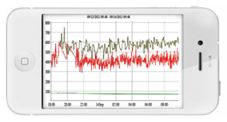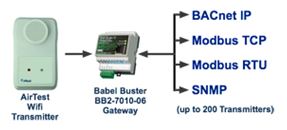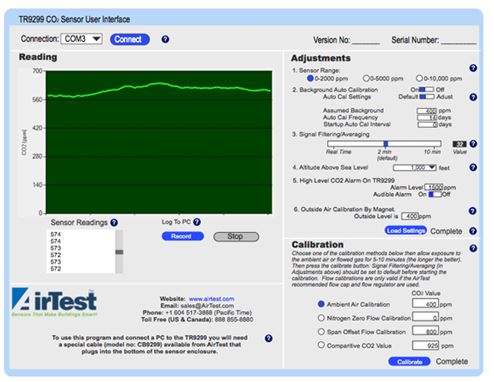|
April 2014
Article
AutomatedBuildings.com
|
[an error occurred while processing this directive]
(Click
Message to Learn More)
|
|
Addressing the Retrofit Need
A Commissioning-Friendly, Battery Powered, Wireless CO2
Transmitter (WiFi)
|
Mike
Schell,
VP of Marketing and Business Development
AirTest
Technologies Inc.
|
The Case For CO2 DCV
Demand controlled ventilation (DCV) offers great potential for energy
savings and better moisture control in buildings by modulating outside
air ventilation to building spaces based on actual occupancy.
This technology offers great potential for savings in retrofit
applications. For example a study of 100 commercial buildings by the US
EPA found that the majority (83%) of buildings were ventilated well
over the ventilation standard of 20 cfm/person with average ventilation
rates being 29.8 cfm based on design occupancy (Ventilation Design And
Performance In US Office Buildings, ASHRAE Journal, April 2005)
Use of CO2 sensors for ventilation control in these buildings would
eliminate this over-ventilation by providing a real time control
feedback to ensure that the appropriate ventilation level in
these buildings is maintained based on actual occupancy.
The savings delivered from DCV can be significant, particularly
for higher density applications with variable occupancy such as
schools, retail stores and malls, hospitality venues, auditoriums and
meeting spaces. Airtest actually offers a free excel-based tool
that allows you to determine potential CO2 DCV savings based on
engineered weather data for over 200 locations throughout North
America. A number of utilities have actually used this program as
a basis for calculating rebates for CO2 DCV. The program is
available here:
https://airtest.com/support/energy-analysis/co2energyanalysis.php.
Typical savings can be 15% to 40% of heating and cooling costs and can
amount to thousands of dollars for many building types.
While CO2 transmitter cost is generally well below $200, the cost of
installation in a retrofit application can be five to 15 times the cost
of
the sensor, all related to wiring and integration with the existing
building control system. This can push energy savings paybacks out
beyond four and five years for some applications. With the
elimination
of most of the installation cost, there becomes a much greater
opportunity for CO2 DCV retrofits.
A WiFi CO2 Transmitter Designed for Retrofit Applications
While the wireless application of a wide variety of sensors has
occurred in the building control industry, the power consumption
problem has held back CO2 sensing and control. AirTest has a
great interest in reducing the total installed cost for a CO2 sensor in
order to allow building owners to reap maximum payback in energy
savings. As a result we have developed the TR9299-WiFi, the
first battery powered WiFi CO2 and temperature transmitter using
an LED-based CO2 sensor platform that consumes less than 1% of
the energy of a conventional CO2 sensor. The incremental per unit
cost of incorporating a wireless capability into the CO2
transmitterdesign, is a fraction of the wired installation cost per
sensor, and allows integration of the sensor with the most widespread,
well established, and dependable wireless technology used today…
WiFi. Soon to come are versions targeting Zigbee Pro and
EnOcean communication platforms.
The TR9299 is designed to have a battery life of approximately
three years on two AA lithium batteries (sampling every two minutes and
broadcasting every 10 minutes). For building operators who are
not excited about changing out batteries ever, the transmitter can also
be low voltage powered (5-24 VAC/VDC). The TR9299 also has an
on-board data logger capable of storing over 3,000 measurement points,
which will make it ideal for some temporary measurement
applications. An on board visual and audio indicator can also be
activated to warn of elevated levels if desired (i.e. LEED credits for
IAQ monitoring). The transmitter also features a background auto
calibration function that can be activated via a plug-in PC user
interface. Further technical details on the product can be found
here: http://www.airtest.com/support/datasheet/TR9299wifi.pdf.
Versions of the transmitter are also available to measure:
All WiFi transmitters are designed to offer significant versatility on
how the WiFi communication capability is used.
 Data from the sensor can be
directed to a website
hosted by AirTest. The website features data storage, and
the data can be viewed in a number of ways including graphing, setting
alarm levels for each transmitter, activating email or text alarm, and
requiring alarm acknowledgment including the provision of alarm
escalation if an alarm is not acknowledged. There is a nominal
monthly fee for this web hosting service.
Data from the sensor can be
directed to a website
hosted by AirTest. The website features data storage, and
the data can be viewed in a number of ways including graphing, setting
alarm levels for each transmitter, activating email or text alarm, and
requiring alarm acknowledgment including the provision of alarm
escalation if an alarm is not acknowledged. There is a nominal
monthly fee for this web hosting service.
- Data can be sent to any address on the
Internet be
it an SQL database, IP capable controller, or cloud based data
collection platform. All that is required is to write a
small translation utility to decompress and interpret the data-packets
sent from each sensor (protocol details are available at no cost).
 Control Solutions Inc. has developed an
inexpensive gateway product (BB2-7010-06): www.AirTest.com/support/datasheet/BB2-7010-06, that
when connected to a
local WiFi network can provide a BACnet/IP client and server, Modbus
TCP client and server (master and slave), SNMP client and server
(agent), and Modbus RTU master and slave. The BB2-7010-06
includes a WiFi sensor server, which collects data via a WiFi access
point from AirTest WiFi transmitters. Up to 200 transmitters can
be connected via one gateway.
Control Solutions Inc. has developed an
inexpensive gateway product (BB2-7010-06): www.AirTest.com/support/datasheet/BB2-7010-06, that
when connected to a
local WiFi network can provide a BACnet/IP client and server, Modbus
TCP client and server (master and slave), SNMP client and server
(agent), and Modbus RTU master and slave. The BB2-7010-06
includes a WiFi sensor server, which collects data via a WiFi access
point from AirTest WiFi transmitters. Up to 200 transmitters can
be connected via one gateway.
A Commissioning Friendly CO2 Transmitter
We
have been selling CO2 sensors and transmitters for over 10 years
and one of the biggest concerns we heard recently is that CO2
transmitters are not “Commissioning Friendly”. Basically, sensors
have been designed to be factory calibrated and end users have been
discouraged from trying to adjust the sensors in the field because
field calibration can be subject to all kinds of variables that could
cause significant error in the calibration process. This has
caused a significant problem for commissioning agents, who are
responsible for verifying sensor operation and readings. It is
often also a headache for contractors who need the commissioning
agent’s report to get paid. Because the sensor elements are
embedded in larger enclosures there is no easy way to verify readings
except by comparing with a calibrated portable device in the immediate
area of the sensor.
It is important to note that the TR9299 does have a background
calibration feature that can be activated and even customized by the
user. User inputs include the ability to set the background
concentration used for calibration, the interval that should be used to
sample background concentrations, and the ability to program a quick
initial background calibration that occurs soon after initial power up.
In designing the TR9299-Wifi thought carefully about how to
make commissioning fast, non-complicated and accurate. We have
developed two approaches that we think considerably enhance the
commissioning process.
- Ambient Air
Calibration: CO2 DCV control is
based on measuring the difference between inside and outside
concentrations. A very effective way to calibrate sensors is to
expose them to outside air concentrations and assume a baseline value
such as 400 ppm. With the battery operated TR9299 the transmitter
can easily be removed from the wall and placed outside for 10-15
minutes. A small magnet that is held on the back of the sensor
can be removed and placed on the outside of the front cover of the
transmitter to initiate the ambient calibration. A flashing light
on the cover of the transmitter indicates when the calibration is
complete.
- Using A Known
Concentration Of Gas: One of
the reasons for the circular shape on the front of the transmitter is
to fit a calibration cap that allows the flow of a known gas to the
sensor in a controlled way that will ensure maximum accuracy.
Using a plug-in PC interface developed by AirTest, the user can compare
or actually adjust calibration of the sensor based on flowing a known
concentration of gas, or flowing nitrogen to confirm the zero point, or
simply comparing the sensor reading to a recently calibrated hand held
device. While performing the calibration, readings can also be
graphed on the interface and logged to a PC with time/date indicators
creating a permanent record of the commissioning or calibration
process.

Adjustment
interface for the TR9299
Summary
[an error occurred while processing this directive]
CO2 Demand Controlled Ventilation can save considerable energy in
buildings by regulating fresh air ventilation based on actual
occupancy. However, the payback of installing these sensors can
be considerably lengthened in retrofit applications where the cost of
wiring and integrating CO2 can be 5 to 15 times the cost of the CO2
Transmitter. Due to a breakthrough in the design of infrared LED
technology, the power consumption of CO2 sensors can be reduced by up
to 99% making battery powered, wireless sensors possible. Temperature
generation by the sensor that can affect the readings of nearby
humidity and temperature sensors is also eliminated.
The AirTest CO2 transmitter design also provides a “Commissioning
Friendly” feature set that allows for a wide variety of methods to
quickly and accurately verify or perform a calibration. Following
the production roll out of the TR9299-WiFi transmitter in May of this
year will be versions designed for other wireless protocols including
ZigBee Pro and EnOcean.
About the Author
Mike
Schell is VP of Marketing and Business Development for AirTest
Technologies Inc. a Canadian company that offers a wide variety of
sensor technologies for buildings. Mike has extensive experience in
sensor technologies and building control, and was a co-founder of the
first company to market low cost CO2 sensors for Demand Controlled
Ventilation. Mike was instrumental in ensuring the acceptance of
this innovative technology by today’s codes and standards.
He has authored over 70 articles and papers on indoor air quality,
building science and environmental control.
footer
[an error occurred while processing this directive]
[Click Banner To Learn More]
[Home Page] [The
Automator] [About] [Subscribe
] [Contact
Us]
 Data from the sensor can be
directed to a website
hosted by AirTest. The website features data storage, and
the data can be viewed in a number of ways including graphing, setting
alarm levels for each transmitter, activating email or text alarm, and
requiring alarm acknowledgment including the provision of alarm
escalation if an alarm is not acknowledged. There is a nominal
monthly fee for this web hosting service.
Data from the sensor can be
directed to a website
hosted by AirTest. The website features data storage, and
the data can be viewed in a number of ways including graphing, setting
alarm levels for each transmitter, activating email or text alarm, and
requiring alarm acknowledgment including the provision of alarm
escalation if an alarm is not acknowledged. There is a nominal
monthly fee for this web hosting service.  Control Solutions Inc. has developed an
inexpensive gateway product (BB2-7010-06): www.AirTest.com/support/datasheet/BB2-7010-06, that
when connected to a
local WiFi network can provide a BACnet/IP client and server, Modbus
TCP client and server (master and slave), SNMP client and server
(agent), and Modbus RTU master and slave. The BB2-7010-06
includes a WiFi sensor server, which collects data via a WiFi access
point from AirTest WiFi transmitters. Up to 200 transmitters can
be connected via one gateway.
Control Solutions Inc. has developed an
inexpensive gateway product (BB2-7010-06): www.AirTest.com/support/datasheet/BB2-7010-06, that
when connected to a
local WiFi network can provide a BACnet/IP client and server, Modbus
TCP client and server (master and slave), SNMP client and server
(agent), and Modbus RTU master and slave. The BB2-7010-06
includes a WiFi sensor server, which collects data via a WiFi access
point from AirTest WiFi transmitters. Up to 200 transmitters can
be connected via one gateway.